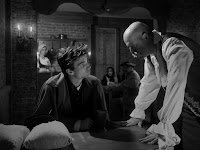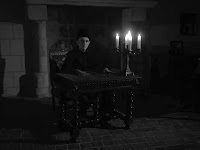Director: Gérard Seigneur
Release date: 2023 (2022)
Contains spoilers
Though copyrighted for 2022, I have seen that production was ongoing in December of that year so have assumed a 2023 release date – there is, at time of writing, no IMDb page for conformation. I understand there is a version of this film with dialogue, however I have watched the silent version with intertitles (and a small piece of audio dialogue in the bookends to the film). The bookends are colour, whilst the majority of the film as presented is black and white – there is a colour flashback sequence. My thanks to Adrien who informed me of the film’s existence. I watched this on YouTube. There are no English subtitles but the Google translator app on my phone is a marvellous thing.
 |
| playing with the cat |
So, this is a French language remake of Nosferatu, eine Symphonie des Grauens and, I perceive, one done in tribute – especially as it was made in the 100th anniversary year of the original masterpiece. Filmed silent (there is, as mentioned, a dialogue version also) it does mirror the original quite closely but veers off massively at the end and I will spoil that. All the names are changed. The opening colour sequence sets the scene and then we meet Alice (Juliette Perfetto) playing with her cat. Husband Louis (Andrea Poupard) leaves the house and gets flowers from Doctor Bonnin (Gérard Seigneur) and takes them to her – and they embrace.
 |
| the letter |
Changes are seen already. If being true to the original, Louis (or Hutter) would meet the Doctor (Bulwer) on the way to work but, more significantly, Alice (or Ellen) would mourn the flowers being cut. Be that as it may, Louis then does go to work and an intertitle suggests that his employer, Dublineau (also Gérard Seigneur) – Knock, in the original, of course – is a bad man with plenty of rumours circulating about him. He has received a letter, in occult script, from the Count of Aulan – or Nosferatu (Philippe Seigneurin), and there is a reason for separating the two out, which I’ll come to. Dublineau sends Louis with papers to sell the Count a house in the town.
 |
| in the inn |
Before he leaves, he visits the Doctor who shows him the mysterious microscopic world and a Venus Flytrap in action – lifting the Bulwer, science sequence from the original forward and given to Louis rather than students. He then leaves Alice with his in-laws and rides off to meet the Count. There is quite a bit of riding footage and then he gets to the inn. He is, of course, warned about his journey but interestingly he is also told that the real Count has been dead for some time. A handily placed book on vampires suggests Nosferatu was born in 1443. Back home Dublineau conducts occult/alchemical experiments – and this could have been interesting if capitalised on by explicitly connecting this with his being committed to the asylum, but it was not.
 |
| meeting the Count |
Louis goes to the castle, but we have seen a hooded figure look through his window at the inn and a hooded figure picks him up in a carriage – I noted here that it was clearly daytime as we got sun glare in the photography. I don’t think it was a day for night error rather I think this Count has servants. When Louis reaches the castle another hooded figure leads him to the Count who is sitting at a desk. The Count’s makeup is rather simple – revealed bald later, he has pointed ears and obvious makeup to make him look gaunt. When we see fangs they are more to the side than front. There is a portrait in the room, clearly Alice, though no comment is made by Louis and, when the Count sees the small portrait Louis carries, he makes no comment about the likeness. So let us turn to Alice for it is here that the changes, and issues, begin.
 |
| colour memory |
Alice is not shown reacting on the first night that Louis is attacked but she does react the second night. But where the original can be read that her psychic link is with either her husband or the vampire, here it is clearly with Louis. Later, when she gets his letter, she (clairvoyantly) knows he is in danger and might be dead. However, the film does tap into the reincarnation trope of the wider megatext and we get a memory or flashback sequence later, shown in colour, of her as the Countess with the Count of Aulan (Eneko Darrigo) – note the change in actor. She falls and dies, he commits suicide and is transformed in the grave (and the grave is transformed also) into Nosferatu (and the vampire is credited as Nosferatu). Where this became confused is that they chose to use a different actor and the grave states 1723 – some time beyond the 1443 date in the book. Did the suicide allow the vampire to take the real Count’s place? The sequence is shot as though they are the vampire’s memories, so perhaps they are one and the same and the dates are wrong? We just don’t know.
 |
| the shadow on the stairs |
This reincarnated love aspect is not capitalised on at all and here we come to the even bigger changes. Louis gets back before the Count arrives and brings plague to the town. Alice reads the book and sees the answer to the vampire is to offer blood by consent – there is no purity aspect mentioned. As in the original she sends her husband off and essentially invites the vampire in – the shadow sequence is not well realised unfortunately. The vampire bites and… she dies, the sun hasn’t risen and the Doctor and Louis find her body. The dying in the sun is removed, worse, the men then go and stake the Count – so the female agency, so important in the original film, is absolutely removed.
 |
| staking |
I do have to say that the staking sequence is nicely done and I liked the vampire, metal stake part embedded, grabbing Louis by the throat until the job is finished by the Doctor (who has way more Agency here than the original, and I think there was an under-communicated aspect of science defeating the occult, where the original film had the man of science as ineffectual and almost irrelevant). I should mention that Dublineau does not escape the asylum as Knock did. Interestingly they have the castle fall to ruin once the vampire dies, taking a moment that was in Stoker’s notes for Dracula but not the finished novel. I also need to mention that there are two moments of crap bat syndrome within the film.
 |
| Philippe Seigneurin as Nosferatu |
Overall, however, this was clearly an ode but I did not like the big changes to the end of the film. Of course a filmmaker is free to do what they like but the death at dawn aspect of the original film is so iconic and so important to the megatext that, whatever else I changed (were I to try and rescript Nosferatu) I would never touch that, nor would I remove the agency that Ellen displayed. Of course, I have not watched the sound version but the silent acting had a level of mummery to it that I think is born from the fact that the exaggeration needed for such an art is no longer needed when acting in modern films normally. Some of the, clearly budget driven, sets were a bit silly. The ship becomes a sailed river sloop, but the log still mentions sea ports and they pretend this very low to the water vessel has a hold it could never have. Still, I appreciate the love for the original that this shows. 5 out of 10.


No comments:
Post a Comment